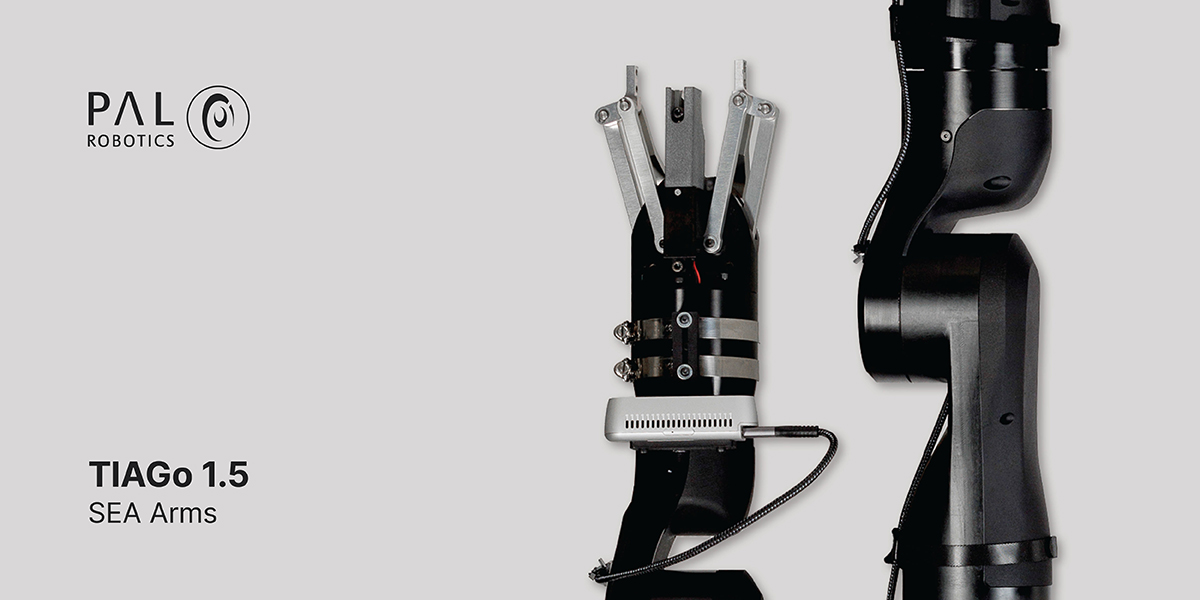The TIAGo family of robots are well known in the field of mobile manipulation for combining perception, navigation, manipulation, and Human-Robot Interaction skills. TIAGo robots have applications in diverse research areas, from Ambient-Assisted Living to Healthcare and Light Industry. The TIAGo family offers customisation options, including the choice of one or two arms and differential or omnidrive bases. At PAL Robotics we are happy to announce the introduction of a new addition to the TIAGo customisation lineup – the TIAGo SEA arm, which has been designed to address a wide range of research needs.
Advancements in the field of mobile manipulation have enabled robots to perform tasks in diverse environments. Yet, the field of mobile manipulation faces multiple challenges, from precise perception and object recognition to accurate control and Human-Robot Collaboration.
Development of the new TIAGo SEA arm through the CANOPIES project: enabling precision agriculture
The latest addition to the TIAGo family, the SEA arm, was initially developed during the EU project CANOPIES. CANOPIES is revolutionising agriculture by facilitating collaboration between farm workers and robots for tasks like harvesting and pruning in table-grape vineyards. In order to address these challenges, significant upgrades were made to the robot’s arm during the project.
Specifications of the new TIAGo SEA arm including joint brakes and torque control
The new TIAGo SEA arm boasts impressive specifications and benefits that range from enhanced safety to a higher arm reach. These are the main specifications and benefit of the new arm:
- 7 Degrees of Freedom (DoF): The redundancy of the arm provides exceptional dexterity, combining complex movements and precise manipulation.
- Extended Reach (96cm): A greater workspace and higher reach expand the range of applications.
- Joint Brakes: These enhance safety, enabling safe collaboration between robots and humans. Joint brakes facilitate emergency stops and prevent excessive force exertion during interactions.
- Torque Control with Series Elastic Actuators: This feature ensures compliance, making it suitable for delicate tasks and Human-Robot Collaboration.
- Ethercat Bus at 1 KHz: Real-time communication at high speeds, perfect for applications demanding rapid data exchange and synchronisation.
- ISO 9409-1 Mounting Flange: Standardised end-effector attachment for effortless interchangeability.
Impedance Control and gravity compensation: adapting to diverse applications
In addition to torque control, the new arm incorporates impedance control, allowing the robot to adjust its compliance based on the task.
Torque control is a method used in robotics and engineering to precisely control the applied effort at motor or actuator level. It is a fundamental aspect of robotic control systems, especially in applications where precise control of motion and interaction with the environment is essential.
Impedance control is especially useful for applications requiring different levels of stiffness, compliance, or damping, as it enables the robot to switch seamlessly between various tasks and environments. Furthermore, to enhance safety, ensuring a safe working environment, the arm is reactive to external disturbances while maintaining the target position as an objective.
Impedance control is based on torque control by closing the loop in position to achieve more adaptable and versatile robotic behaviour in various applications, from industrial automation to medical robotics.
With the inclusion of gravity compensation, operating the robot’s arm becomes a seamless endeavour, allowing for precise movement as it dynamically adjusts motor force to maintain its position. Additionally, the robot features a learning by demonstration functionality, employing the gravity compensation mode to facilitate the physical instruction of new tasks.
CANOPIES: Revolutionising Agriculture and Beyond
CANOPIES is the first attempt to introduce a collaborative prototype in precision agriculture for permanent crops. The overall goal of the EU research project CANOPIES project is to develop a robotic prototype in crop farming (Agri-Food) that addresses the challenges of Human-Robot Interaction and Human-Robot Collaboration.
PAL Robotics’ main role in this project is to provide the upper body of the agricultural robot demonstrator, formed from the TIAGo++ dual-armed robot, which has been placed on top of the Alitrack base, provided by The Sapienza University of Rome.
The agronomically adapted dual arm design is also accompanied by custom CANOPIES gripper designs that will allow the execution of the harvesting and pruning tasks. In addition, these alterations will allow CANOPIES to operate the robot in compliant control, making it more suitable for human workers to share their workspace with the robot.
This adapted agricultural robot design for CANOPIES will prevent exerting any strong force against obstacles or people, which is also very useful to other fields of application, such as healthcare, retail, and agile manufacturing.
During the project tests were held in an agricultural cooperative named “Cooperativa Agricola Corsira”, a community of roughly 20 small producers in Aprilia, Lazio, Italy. The challenge here was that using robotics for harvesting and pruning requires the development of complex robotic processes of perception, communication, shared planning in agreement, prediction of human intentions, interaction, and action.

